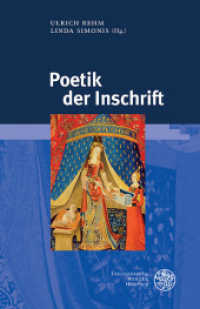Full Description
2020 Second Place, Best Nonfiction Multi Author, International Latino Book Awards
Collecting the perspectives of scholars who reflect on their own relationships to particular garments, analyze the politics of dress, and examine the role of consumerism and entrepreneurialism in the production of creating and selling a style, meXicana Fashions examines and searches for meaning in these visible, performative aspects of identity.
Focusing primarily on Chicanas but also considering trends connected to other Latin American communities, the authors highlight specific constituencies that are defined by region ("Tejana style," "L.A. style"), age group ("homie," "chola"), and social class (marked by haute couture labels such as Carolina Herrera and Oscar de la Renta). The essays acknowledge the complex layers of these styles, which are not mutually exclusive but instead reflect a range of intersections in occupation, origin, personality, sexuality, and fads. Other elements include urban indigenous fashion shows, the shifting quinceaÑera market, "walking altars" on the Days of the Dead, plus-size clothing, huipiles in the workplace, and dressing in drag. Together, these chapters illuminate the full array of messages woven into a vibrant social fabric.
Contents
Introduction (AÍda Hurtado and Norma E. CantÚ)
Section I. Rendering of Self: Personal Narratives/Personal Adornment
Chapter 1. Wearing Identity: Chicanas and Huipiles (Norma E. CantÚ)
Chapter 2. Con el huipil en la mente: The Metamorphosis of a Chicana (Josie MÉndez-Negrete)
Chapter 3. "Rebozos, huipiles, y ¿QuÉ?": Chicana Self-Fashioning in the Academy (Micaela DÍaz-SÁnchez)
Chapter 4. Por la facha y por el traje, se conoce al personaje: Tales about Attire as Resistance and Performativity in a Chicana's Life Trajectory (Gabriella GutiÉrrez y Muhs)
Chapter 5. A Familial Legacy of meXicana Style (Domino Renee Perez)
Section II. The Politics of Dress: Saying It Loud/Saying It Clear
Chapter 6. Buying the Dream: Relating "Traditional" Dress to Consumer Practices within US QuinceaÑeras (Rachel Valentina GonzÁlez-Martin)
Chapter 7. Visuality, Corporality, and Power (AÍda Hurtado)
Chapter 8. Black, Brown, and Fa(t)shionable: The Role of Fat Women of Color in the Rise of Body Positivity (Jade D. Petermon)
Chapter 9. Fashioning Decolonial Optics: Days of the Dead Walking Altars and Calavera Fashion Shows in Latina/o Los Angeles (Laura PÉrez)
Chapter 10. "Fierce and Fearless": Dress and Identity in Rigoberto GonzÁlez's The Mariposa Club (Sonia Alejandra RodrÍguez)
Section III. The Politics of Entrepreneurship: Making (It)/Selling (It))
Chapter 11. Lydia Mendoza, "Reina de la MÚsica Tejana": Self-Stylizing Mexicanidad through China Poblana in the US-Mexico Borderlands (Marci R. McMahon)
Chapter 12. (Ad)Dressing Chicana/Latina Femininities: Consumption, Labor, and the Cultural Politics of Style in Latina Fashion (Stacy I. MacÍas)
Chapter 13. Urban Xican/x-Indigenous Fashion Show ARTivism: Experimental Ethnographies and Perform-Antics in Three Actos (Chela Sandoval, Amber Rose GonzÁlez, and Felicia Montes)
Contributors
Index








